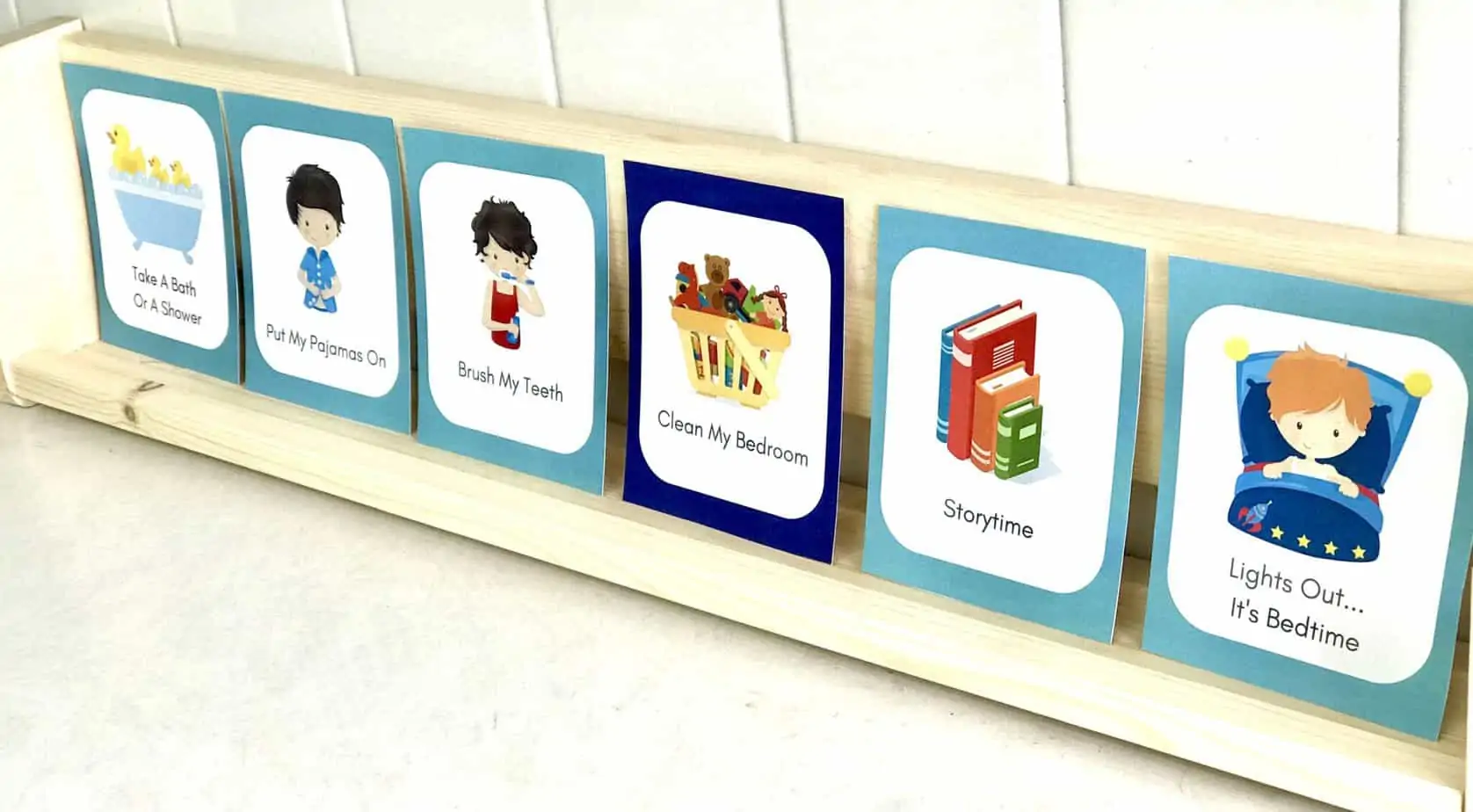If you’re having trouble getting your toddler to fall asleep and stay asleep, try this smart toddler bedtime routine they won’t fight, but will actually love. Plus, how to incorporate routine cards to make bedtime even smoother!
The Smart Bedtime Routine Your Toddler Won’t Fight
If bedtime is a hard part of your day, then this smart piece of sleep advice is for you.
I’ve been right where you are, and I know the wrench one child can throw into the bedtime routine when they’ve declared sleep enemy number one.
At the end of a long day when your patience is razor-thin, all you want, is to lovingly tuck your little one in and have them drift off to sleep peacefully and quietly….
But, let’s get real.
That kind of stuff is only for the movies
When you have a child who develops an allergy to bedtime, it’s the time of day when you resort to begging, pleading, throwing out unenforceable consequences, and even yelling.
This is precisely why I had to outsmart my youngest and think of a creative way to tackle our night time routine.
Fair warning.
This toddled bedtime routine involves an incentive that encourages her to follow all the steps to our routine if she wants to receive the reward.
Don’t worry though, the incentive is simple.
It’s something meaningful like an extra book at bedtime or five more minutes of snuggling. It’s not anything purchased or sugary.
How’s this new toddler bedtime routine working in our house?
So far, it’s working like a dream (yes, pun intended), but it’s also helped me stay calm in the evenings when before I wanted to pull out my hair.
The best part?
Taylor’s aversion to nighttime sleep seems to have disappeared as quickly as it came on.
(Thank goodness!)
Pssst… Don’t forget the free Beat the Clock Bedtime Routine Printable at the end.
How Much Should a 2 Year Old Sleep?
In Mastering Kid’s Sleep, Routines and Schedules I teach you all the steps to create a great routine, but right now, I want to give you a starting place when it comes to setting a great bedtime for your child.
The first place to start is with how much sleep your child needs.
According to the American Academy of Pediatrics (AAP) here are the current sleep recommendations for kids at different ages:
- Babies 4 – 12 months: 12-16 hours of sleep per 24 hours (including naps)
- Kids 1 – 2 years: 11-14 hours of sleep per 24 hours (including naps)
- Kids 3 – 5 years: 10-13 hours of sleep per 24 hours (including naps)
- Kids 6 – 12 years: 9-12 of sleep hours per 24 hours
- Teens 13 – 18 years: 8-10 hours of sleep per 24 hours
When you follow these guidelines from the AAP, then you can determine an appropriate bedtime based on when your child wakes up, and how long they nap.
Although you may need to shorten nap time if it’s too long (more than 1 1/2 – 2 hours depending on the child,0 or wake-up is closer than at least five hours from bedtime. Both of these nap factors can contribute to fighting bedtime and having toddler bedtime tantrums.
You can also work backwards if you want, by setting the bedtime first and guiding naps and wake-up time by this.
My kids go to bed at 7:30pm so for my youngest who naps still, I’ve shrunk her nap length to hit the 7:30 bedtime, and naturally let her wake up in the mornings, which I’ve found falls within the range of recommended sleep amount.
Start where you need to.
Say Goodbye to Toddler Bedtime Routine Tantrums
I’ve always used a consistent bedtime routine, especially with my twins who have followed a general routine since they were weeks old.
With Taylor, who has a bit of a wild, rebellious streak, and being the third child whose routine has been more of a flow than a time-based routine like her brother and sister (here’s the different types of routines), it’s little surprise really that she’s bucked our traditional bedtime routine and throws a nightly toddler tantrum when it’s time to turn off the lights.
She’s also always the one who makes me get creative about how I approach rules, boundaries, and even bedtimes with, so I had to figure out what would make her tick and ease into bedtime, but still be fun and cuddly.
After all, her love language is touch (you can find your child’s love language here) and incorporating snuggles or a gentle massage into our routine was key.
Once I focused on what she needs, and what she likes and how she prefers to move from one task to the next, then I could fine-tune our bedtime routine in a way that works like magic.
We both appreciate the calmer and sweeter nighttime routine, too.
Let me tell you how you can use our routine, and the ABCs of how it all works.
The Easiest Bedtime Routine to Fight Off Bedtime Battles
If you don’t have a kitchen timer, this is important to implementing this smart bedtime routine, so I recommend grabbing one you like.
We have a traditional kitchen timer like this one (and it’s magnetic so you can stick it on your fridge or bathroom without misplacing it, which I do often.) A simple digital clock also works perfect for this routine. You just need a timer that counts down and has an alarm when time is up.
The next step is creating your nightly routine and assigning an amount of time for each.
Here’s an example:
- 20 minutes for bath time
- 5 minutes for getting dressed and brushing hair
- 5 minutes for brushing and flossing teeth
- 10 minutes reading books in bedroom with or without Mom/Dad
- 5 minutes to cuddle
When you go through your routine, say aloud how many minutes your child has to do each step. When the timer goes off, it’s time to move to the next step and how many minutes they have for that one.
This is the best part and what my little one loves the most.
If your child does each task with a good attitude and beats the timer, then she gets something extra.
For Taylor, she likes me to read an extra book she picks out, but you could also lay with your child for an extra 10 minutes, rub her back, or tell her a story.
Get creative and also consider what your child’s love language is when you choose a reward, so that they are motivated to work towards that special something “extra.”
The timer is key to keeping on track and helping your child move from one task to the next. It also helps her brain prepare for sleep and seeing the steps in the routine (you can use routine cards for this which visually help your child see the steps, what’s completed and still left.)
What to do if Your Child Doesn’t Like the Reward or Still Fights Bedtime
If your child isn’t motivated by what you offer, then it’s time to ask them what they’d like as a reward.
Simple ask their opinion about what they’re motivated to work for and see if you can find a healthy compromise you both can agree on.
Try to stay away from device use or turning on a television so the blue light doesn’t disrupt their sleep cycles and keep them up even longer.
Here are some ideas:
- Listen to a story podcast in bed (with the lights off) for 10 minutes
- Get a gentle massage
- Look at a photo album
- Listen to a story about your child (like their first birthday or first trip)
- Listen to calm music (with the lights off) for 10 minutes
- Practice 5-10 minutes of bedtime yoga
- Read a chapter of the book you’ve been reading together
You don’t want to chose a physical activity that will wind them back up. Something gentle, calm and quiet would do best for an end-of-the night finale.
Printable Bedtime Routine Chart for Toddlers
I created a template you can print and use to show your toddler what their bedtime routine looks like as well as check boxes when they beat the timer.
This is the “Beat the Clock Bedtime Routine” printable perfect for toddlers (and older kids, too!)
Visual tools for little ones are important for them to see what comes next, as well as track their process. Pair the Beat the Clock Bedtime Routine Printable with routine cards and not only can your child move through the routine independently, but
Heres what it looks like (below) and you can down load your copy by using this link or clicking on the image.
More Bedtime Routine Resources:
- Printable Routine Cards for Kids
- Bedtime Routine: What to Do When a Child Won’t Go to Bed at Night
- Best Hack to Get Kids to Sleep is to Change the Narrative About Nap & Bedtime
- 7 Ways to Beat Bedtime Stalling with Young Kids
- How to Establish a Peaceful Bedtime Routine for Your Baby
- 10 Screen-Free Alternatives Before Bedtime
Want even more?
Shop All Parenting Resources
Shop all of our parenting resources from self-regulation tools and managing big emotions to building self esteem and confidence. There are resources for all seasons of life!










